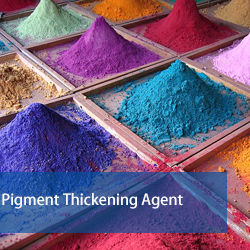On March 26th, at the 2013 China Rubber Annual Conference held by the China Rubber Industry Association in Qingdao, the president of the China Rubber Industry Association, Deng Yachen, stated that in 2013, the economic operation of China's rubber industry will continue to be under downward pressure, but overall it will remain stable. Production and sales are expected to maintain stable growth. The total output value of the rubber industry will reach more than 960 billion yuan, an increase of about 15% from the previous year (the same below).
In 2013, the total tire production in the country will reach 490 million, an increase of 4%; among them, there will be 435 million radial tires, an increase of 5%, and 100 million steel tires in radial tires, an increase of 5%.
A pigment Thickening Agent, also known as a rheology modifier or thixotropic agent, is a type of chemical substance that helps in controlling the viscosity and flow properties of paints, inks, and other pigment-based products. These agents can increase the viscosity of the mixture without changing its other properties such as color, opacity, or drying time.
The primary function of a pigment thickening agent is to prevent the sedimentation of pigments over time, ensuring a more consistent product quality. This is particularly important for products where the pigment concentration is high. Here are some common types of pigment thickening agents:
1. Polymeric Thickeners: These are large molecules made from polymers that form networks within the paint, providing stability and viscosity.
2. Organic Thickeners: These include substances like bentonite, carboxymethyl cellulose (CMC), and polyvinyl alcohol (PVA). They are often used because they are compatible with a wide range of pigments and solvents.
3. Inorganic Thickeners: Examples include clays like bentonite and kaolin. They work by absorbing water and swelling, which increases viscosity.
4. Hydroxyethylcellulose (HEC): A type of cellulose derivative that can be used to thicken aqueous systems. It's biodegradable and food-grade.
5. Cellulose Ether Derivatives: Such as hydroxypropyl methylcellulose (HPMC) and methyl cellulose (MC), which are used in both waterborne and solvent-based systems.
6. Polyacrylates: Synthetic polymers that can be used to adjust viscosity and stabilize dispersions.
7. Silicones: These can be used to modify the surface properties of pigments, affecting their dispersibility and the final viscosity of the mixture.
Choosing the right thickening agent depends on several factors including the type of pigment, the solvent system, the desired viscosity, and the environmental impact considerations. It's crucial to test different agents under similar conditions to ensure compatibility and optimal performance.

Pigment Printing Thickener,Thickener For Pigment Printing,Paint Thickener
Guangzhou Quanxu Technology Co Ltd , https://www.silicamattingagent.com